Case Study: Overcoming Intercultural Communication Barriers
VerifiedAdded on 2022/11/17
|6
|1228
|346
Case Study
AI Summary
This case study report examines the barriers to intercultural communication within a business context, focusing on the interplay of language and culture. It highlights how language differences, non-verbal communication discrepancies (such as body language and eye contact), negative stereotypes, and differing emotional expressions can impede effective communication. The report provides examples of these barriers and discusses their impact on business interactions. Furthermore, the case study offers practical strategies to overcome these challenges, including developing cultural sensitivity, learning key phrases, promoting acceptance of cultural differences, accommodating others' opinions, and creating an interactive environment. The conclusion emphasizes the importance of a culturally accommodative environment in the workplace and the need for a culture-sensitive approach to interactions to foster successful communication across diverse cultural backgrounds.
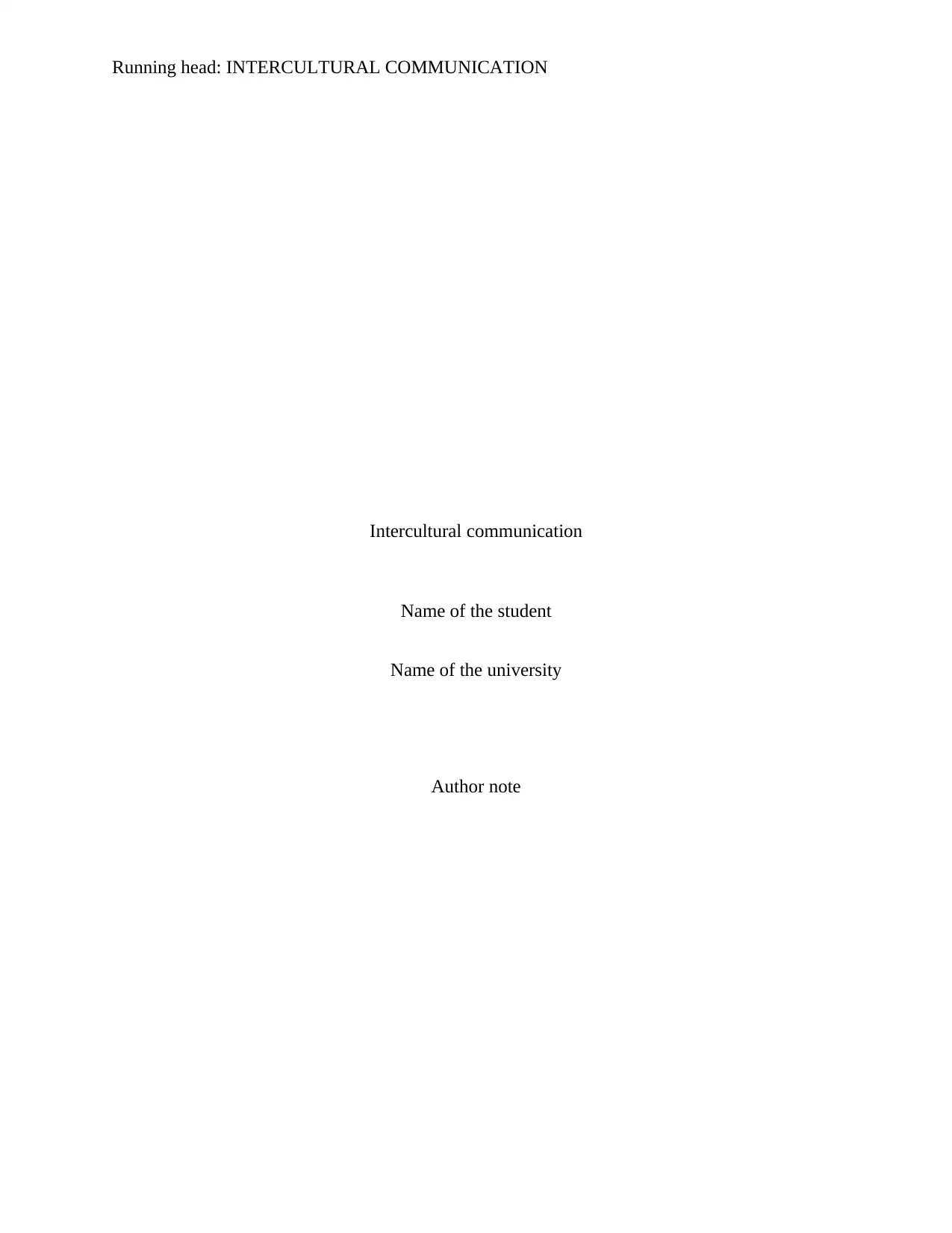
Running head: INTERCULTURAL COMMUNICATION
Intercultural communication
Name of the student
Name of the university
Author note
Intercultural communication
Name of the student
Name of the university
Author note
Paraphrase This Document
Need a fresh take? Get an instant paraphrase of this document with our AI Paraphraser
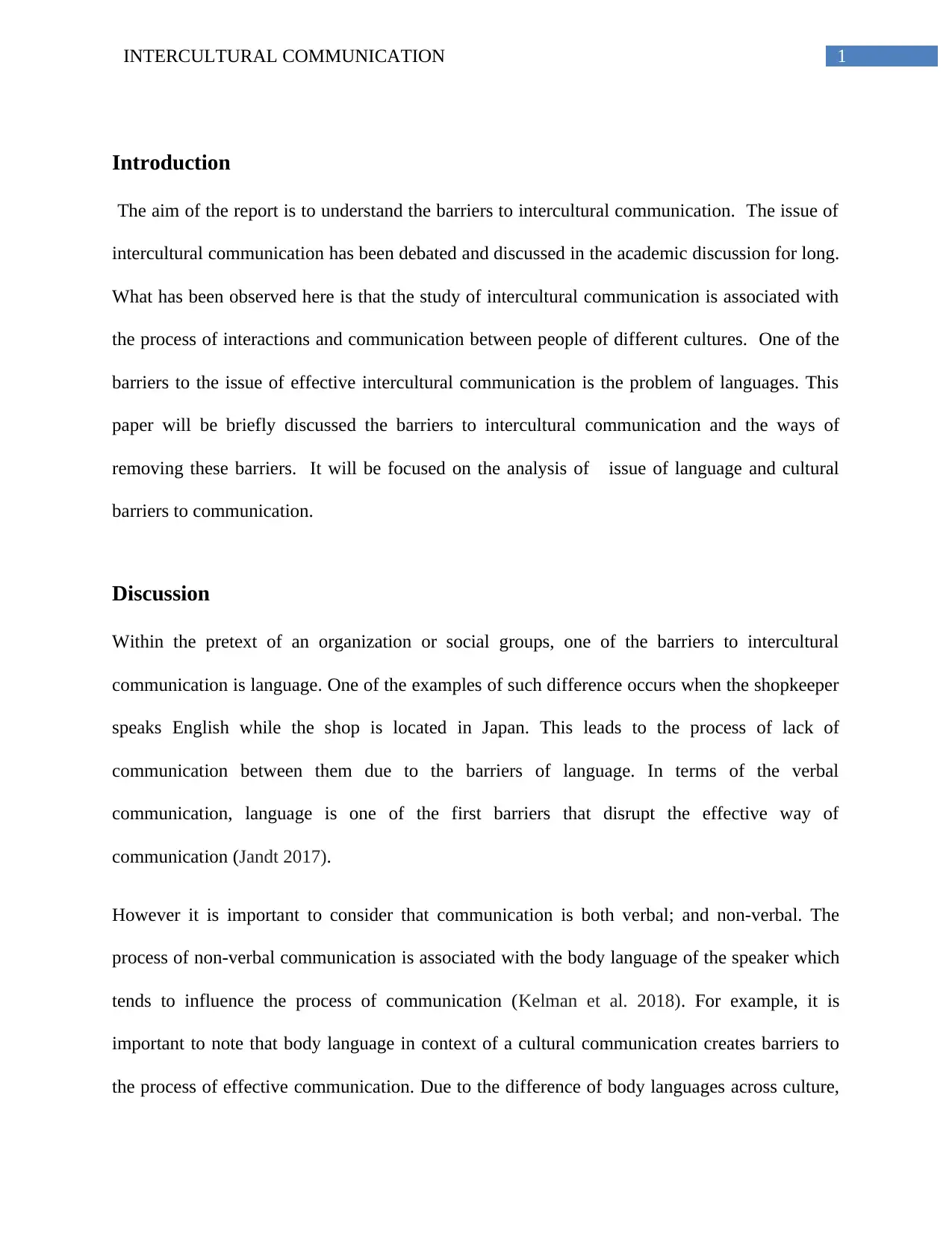
1INTERCULTURAL COMMUNICATION
Introduction
The aim of the report is to understand the barriers to intercultural communication. The issue of
intercultural communication has been debated and discussed in the academic discussion for long.
What has been observed here is that the study of intercultural communication is associated with
the process of interactions and communication between people of different cultures. One of the
barriers to the issue of effective intercultural communication is the problem of languages. This
paper will be briefly discussed the barriers to intercultural communication and the ways of
removing these barriers. It will be focused on the analysis of issue of language and cultural
barriers to communication.
Discussion
Within the pretext of an organization or social groups, one of the barriers to intercultural
communication is language. One of the examples of such difference occurs when the shopkeeper
speaks English while the shop is located in Japan. This leads to the process of lack of
communication between them due to the barriers of language. In terms of the verbal
communication, language is one of the first barriers that disrupt the effective way of
communication (Jandt 2017).
However it is important to consider that communication is both verbal; and non-verbal. The
process of non-verbal communication is associated with the body language of the speaker which
tends to influence the process of communication (Kelman et al. 2018). For example, it is
important to note that body language in context of a cultural communication creates barriers to
the process of effective communication. Due to the difference of body languages across culture,
Introduction
The aim of the report is to understand the barriers to intercultural communication. The issue of
intercultural communication has been debated and discussed in the academic discussion for long.
What has been observed here is that the study of intercultural communication is associated with
the process of interactions and communication between people of different cultures. One of the
barriers to the issue of effective intercultural communication is the problem of languages. This
paper will be briefly discussed the barriers to intercultural communication and the ways of
removing these barriers. It will be focused on the analysis of issue of language and cultural
barriers to communication.
Discussion
Within the pretext of an organization or social groups, one of the barriers to intercultural
communication is language. One of the examples of such difference occurs when the shopkeeper
speaks English while the shop is located in Japan. This leads to the process of lack of
communication between them due to the barriers of language. In terms of the verbal
communication, language is one of the first barriers that disrupt the effective way of
communication (Jandt 2017).
However it is important to consider that communication is both verbal; and non-verbal. The
process of non-verbal communication is associated with the body language of the speaker which
tends to influence the process of communication (Kelman et al. 2018). For example, it is
important to note that body language in context of a cultural communication creates barriers to
the process of effective communication. Due to the difference of body languages across culture,
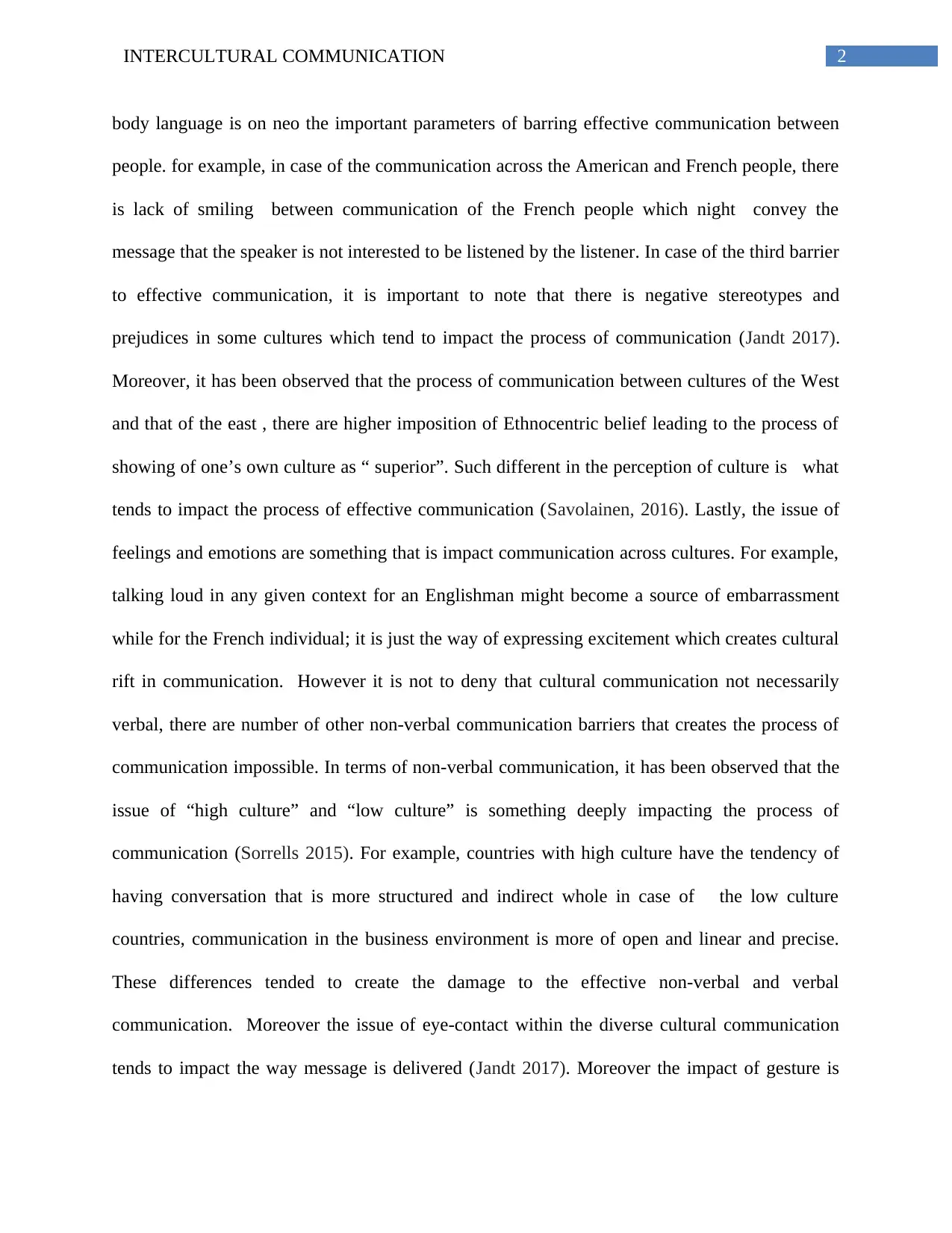
2INTERCULTURAL COMMUNICATION
body language is on neo the important parameters of barring effective communication between
people. for example, in case of the communication across the American and French people, there
is lack of smiling between communication of the French people which night convey the
message that the speaker is not interested to be listened by the listener. In case of the third barrier
to effective communication, it is important to note that there is negative stereotypes and
prejudices in some cultures which tend to impact the process of communication (Jandt 2017).
Moreover, it has been observed that the process of communication between cultures of the West
and that of the east , there are higher imposition of Ethnocentric belief leading to the process of
showing of one’s own culture as “ superior”. Such different in the perception of culture is what
tends to impact the process of effective communication (Savolainen, 2016). Lastly, the issue of
feelings and emotions are something that is impact communication across cultures. For example,
talking loud in any given context for an Englishman might become a source of embarrassment
while for the French individual; it is just the way of expressing excitement which creates cultural
rift in communication. However it is not to deny that cultural communication not necessarily
verbal, there are number of other non-verbal communication barriers that creates the process of
communication impossible. In terms of non-verbal communication, it has been observed that the
issue of “high culture” and “low culture” is something deeply impacting the process of
communication (Sorrells 2015). For example, countries with high culture have the tendency of
having conversation that is more structured and indirect whole in case of the low culture
countries, communication in the business environment is more of open and linear and precise.
These differences tended to create the damage to the effective non-verbal and verbal
communication. Moreover the issue of eye-contact within the diverse cultural communication
tends to impact the way message is delivered (Jandt 2017). Moreover the impact of gesture is
body language is on neo the important parameters of barring effective communication between
people. for example, in case of the communication across the American and French people, there
is lack of smiling between communication of the French people which night convey the
message that the speaker is not interested to be listened by the listener. In case of the third barrier
to effective communication, it is important to note that there is negative stereotypes and
prejudices in some cultures which tend to impact the process of communication (Jandt 2017).
Moreover, it has been observed that the process of communication between cultures of the West
and that of the east , there are higher imposition of Ethnocentric belief leading to the process of
showing of one’s own culture as “ superior”. Such different in the perception of culture is what
tends to impact the process of effective communication (Savolainen, 2016). Lastly, the issue of
feelings and emotions are something that is impact communication across cultures. For example,
talking loud in any given context for an Englishman might become a source of embarrassment
while for the French individual; it is just the way of expressing excitement which creates cultural
rift in communication. However it is not to deny that cultural communication not necessarily
verbal, there are number of other non-verbal communication barriers that creates the process of
communication impossible. In terms of non-verbal communication, it has been observed that the
issue of “high culture” and “low culture” is something deeply impacting the process of
communication (Sorrells 2015). For example, countries with high culture have the tendency of
having conversation that is more structured and indirect whole in case of the low culture
countries, communication in the business environment is more of open and linear and precise.
These differences tended to create the damage to the effective non-verbal and verbal
communication. Moreover the issue of eye-contact within the diverse cultural communication
tends to impact the way message is delivered (Jandt 2017). Moreover the impact of gesture is
⊘ This is a preview!⊘
Do you want full access?
Subscribe today to unlock all pages.

Trusted by 1+ million students worldwide
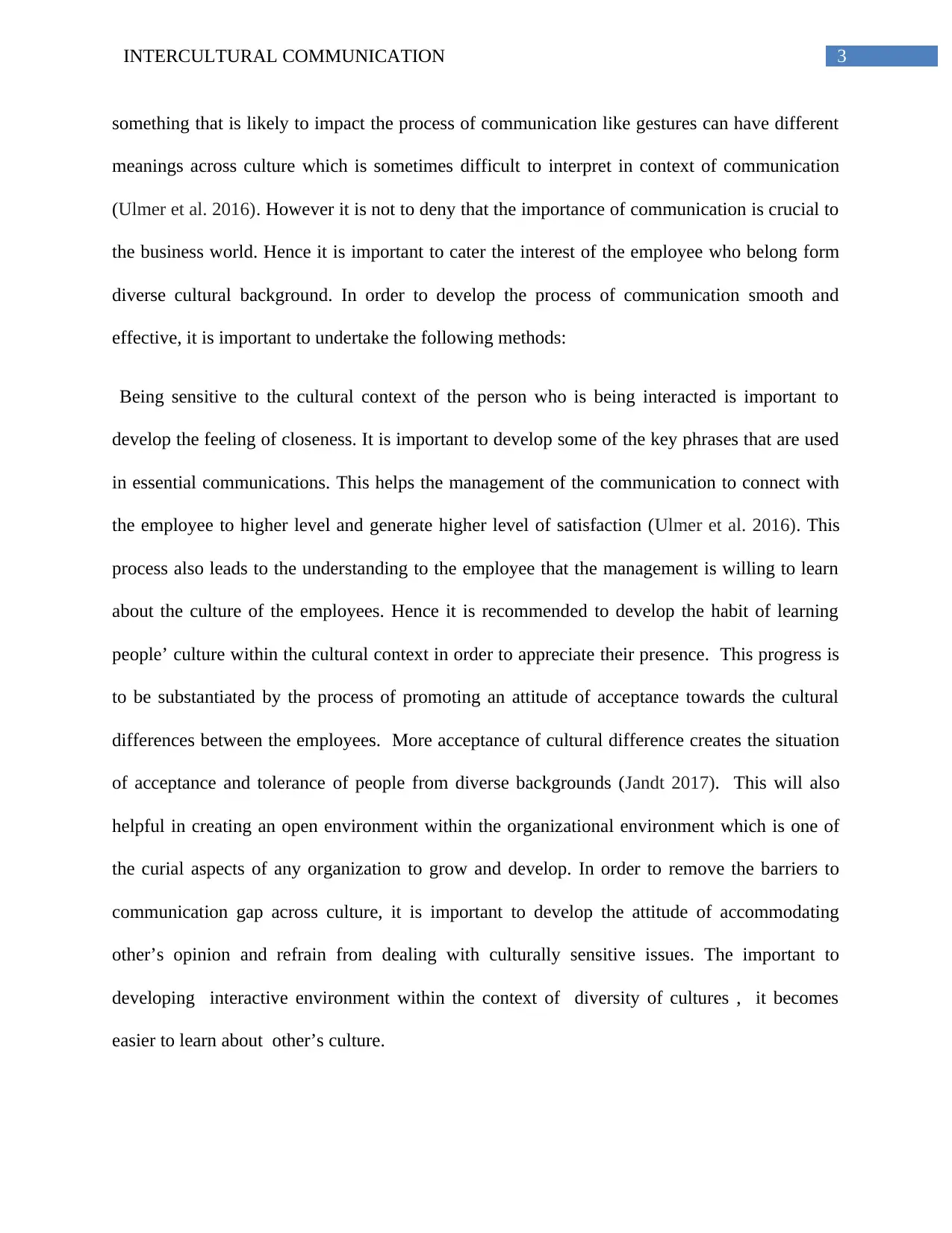
3INTERCULTURAL COMMUNICATION
something that is likely to impact the process of communication like gestures can have different
meanings across culture which is sometimes difficult to interpret in context of communication
(Ulmer et al. 2016). However it is not to deny that the importance of communication is crucial to
the business world. Hence it is important to cater the interest of the employee who belong form
diverse cultural background. In order to develop the process of communication smooth and
effective, it is important to undertake the following methods:
Being sensitive to the cultural context of the person who is being interacted is important to
develop the feeling of closeness. It is important to develop some of the key phrases that are used
in essential communications. This helps the management of the communication to connect with
the employee to higher level and generate higher level of satisfaction (Ulmer et al. 2016). This
process also leads to the understanding to the employee that the management is willing to learn
about the culture of the employees. Hence it is recommended to develop the habit of learning
people’ culture within the cultural context in order to appreciate their presence. This progress is
to be substantiated by the process of promoting an attitude of acceptance towards the cultural
differences between the employees. More acceptance of cultural difference creates the situation
of acceptance and tolerance of people from diverse backgrounds (Jandt 2017). This will also
helpful in creating an open environment within the organizational environment which is one of
the curial aspects of any organization to grow and develop. In order to remove the barriers to
communication gap across culture, it is important to develop the attitude of accommodating
other’s opinion and refrain from dealing with culturally sensitive issues. The important to
developing interactive environment within the context of diversity of cultures , it becomes
easier to learn about other’s culture.
something that is likely to impact the process of communication like gestures can have different
meanings across culture which is sometimes difficult to interpret in context of communication
(Ulmer et al. 2016). However it is not to deny that the importance of communication is crucial to
the business world. Hence it is important to cater the interest of the employee who belong form
diverse cultural background. In order to develop the process of communication smooth and
effective, it is important to undertake the following methods:
Being sensitive to the cultural context of the person who is being interacted is important to
develop the feeling of closeness. It is important to develop some of the key phrases that are used
in essential communications. This helps the management of the communication to connect with
the employee to higher level and generate higher level of satisfaction (Ulmer et al. 2016). This
process also leads to the understanding to the employee that the management is willing to learn
about the culture of the employees. Hence it is recommended to develop the habit of learning
people’ culture within the cultural context in order to appreciate their presence. This progress is
to be substantiated by the process of promoting an attitude of acceptance towards the cultural
differences between the employees. More acceptance of cultural difference creates the situation
of acceptance and tolerance of people from diverse backgrounds (Jandt 2017). This will also
helpful in creating an open environment within the organizational environment which is one of
the curial aspects of any organization to grow and develop. In order to remove the barriers to
communication gap across culture, it is important to develop the attitude of accommodating
other’s opinion and refrain from dealing with culturally sensitive issues. The important to
developing interactive environment within the context of diversity of cultures , it becomes
easier to learn about other’s culture.
Paraphrase This Document
Need a fresh take? Get an instant paraphrase of this document with our AI Paraphraser
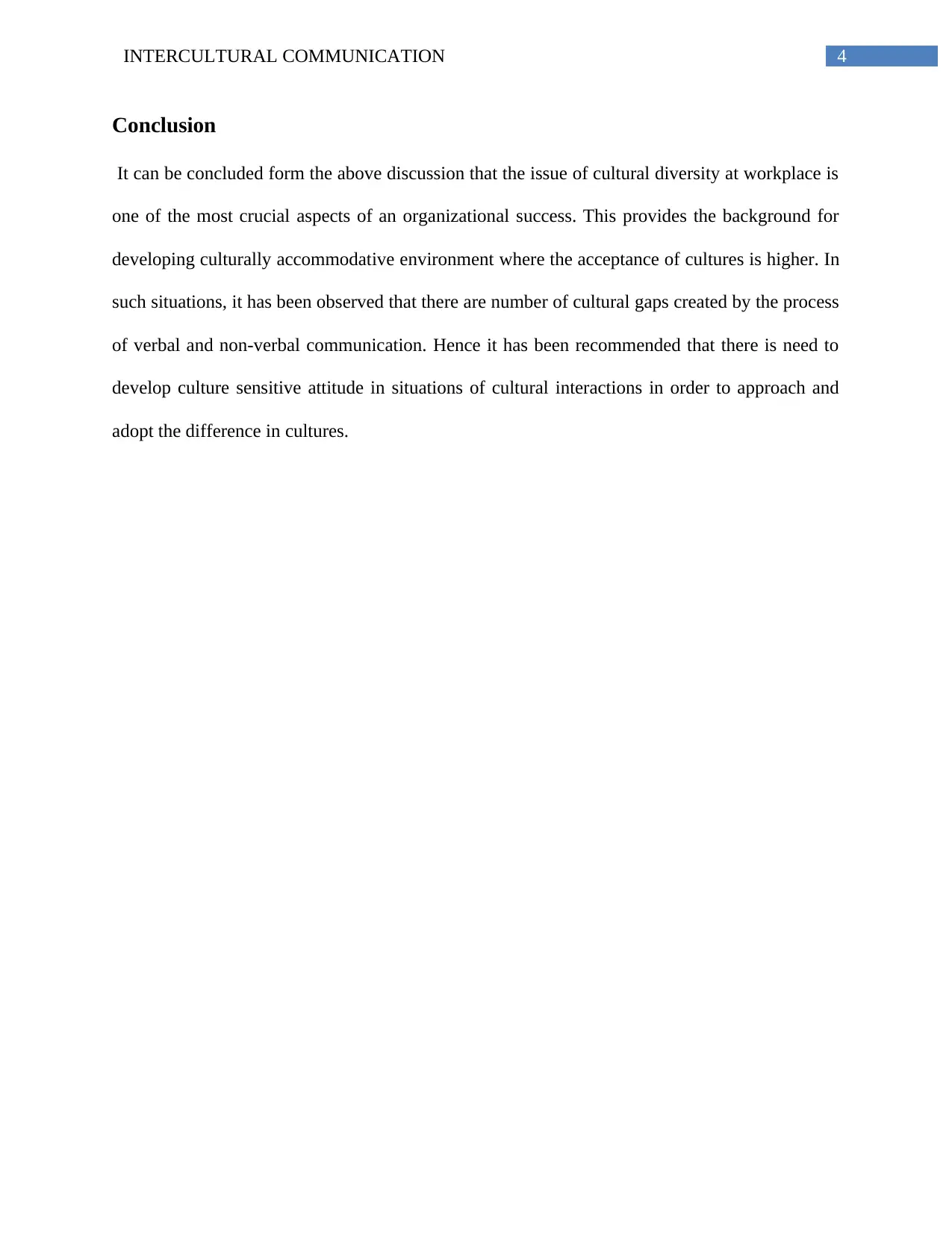
4INTERCULTURAL COMMUNICATION
Conclusion
It can be concluded form the above discussion that the issue of cultural diversity at workplace is
one of the most crucial aspects of an organizational success. This provides the background for
developing culturally accommodative environment where the acceptance of cultures is higher. In
such situations, it has been observed that there are number of cultural gaps created by the process
of verbal and non-verbal communication. Hence it has been recommended that there is need to
develop culture sensitive attitude in situations of cultural interactions in order to approach and
adopt the difference in cultures.
Conclusion
It can be concluded form the above discussion that the issue of cultural diversity at workplace is
one of the most crucial aspects of an organizational success. This provides the background for
developing culturally accommodative environment where the acceptance of cultures is higher. In
such situations, it has been observed that there are number of cultural gaps created by the process
of verbal and non-verbal communication. Hence it has been recommended that there is need to
develop culture sensitive attitude in situations of cultural interactions in order to approach and
adopt the difference in cultures.

5INTERCULTURAL COMMUNICATION
References
Jandt, F.E., 2017. An introduction to intercultural communication: Identities in a global
community. Sage Publications.
Kelman, H.C., 2018. LANGUAGE AS AID AND BARRIER TO INVOLVEMENT. Selected
Studies and Applications, p.185.
Savolainen, R., 2016. Approaches to socio-cultural barriers to information seeking. Library &
information science research, 38(1), pp.52-59.
Sorrells, K., 2015. Intercultural communication: Globalization and social justice. Sage
publications.
Ulmer, R.R. and Pyle, A.S., 2016. International Organizational Crisis Communication. The
handbook of international crisis communication research, 43, p.108.
References
Jandt, F.E., 2017. An introduction to intercultural communication: Identities in a global
community. Sage Publications.
Kelman, H.C., 2018. LANGUAGE AS AID AND BARRIER TO INVOLVEMENT. Selected
Studies and Applications, p.185.
Savolainen, R., 2016. Approaches to socio-cultural barriers to information seeking. Library &
information science research, 38(1), pp.52-59.
Sorrells, K., 2015. Intercultural communication: Globalization and social justice. Sage
publications.
Ulmer, R.R. and Pyle, A.S., 2016. International Organizational Crisis Communication. The
handbook of international crisis communication research, 43, p.108.
⊘ This is a preview!⊘
Do you want full access?
Subscribe today to unlock all pages.

Trusted by 1+ million students worldwide
1 out of 6
Related Documents
Your All-in-One AI-Powered Toolkit for Academic Success.
+13062052269
info@desklib.com
Available 24*7 on WhatsApp / Email
![[object Object]](/_next/static/media/star-bottom.7253800d.svg)
Unlock your academic potential
Copyright © 2020–2025 A2Z Services. All Rights Reserved. Developed and managed by ZUCOL.



